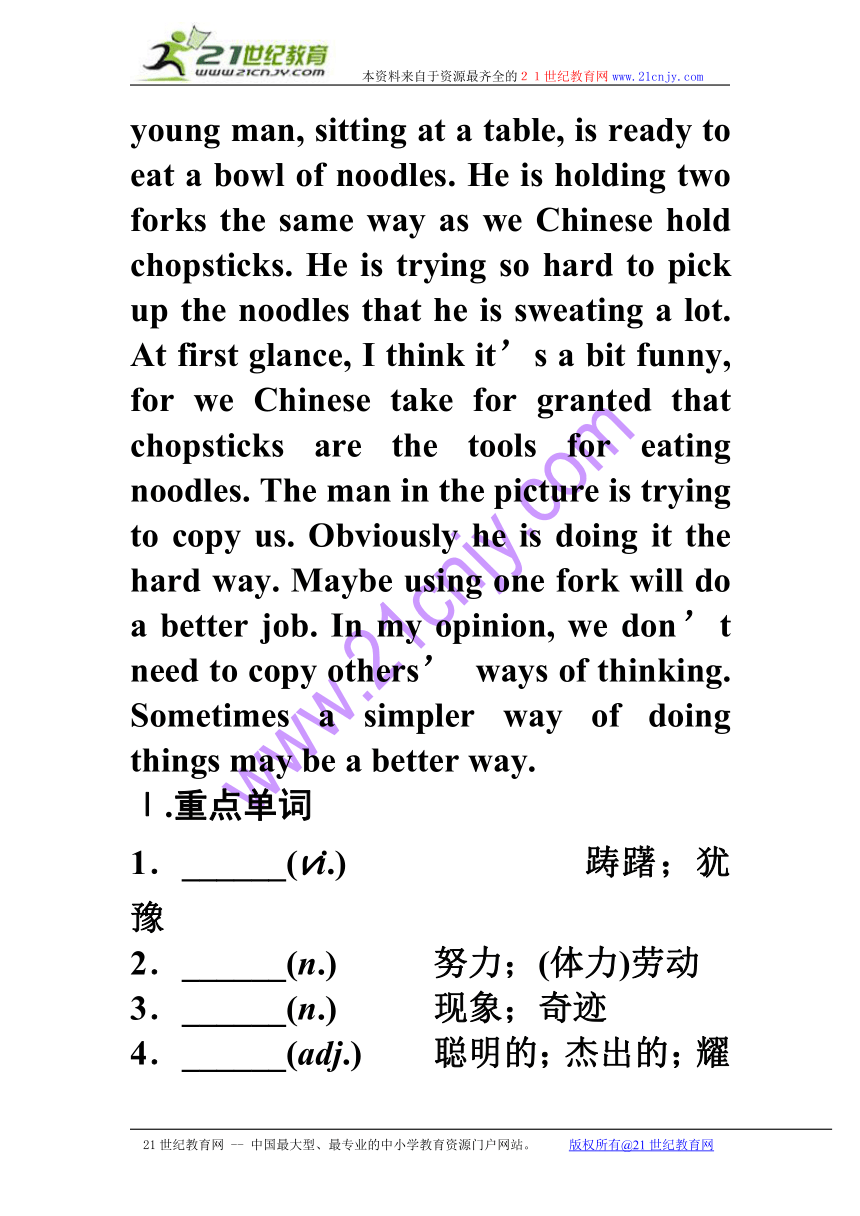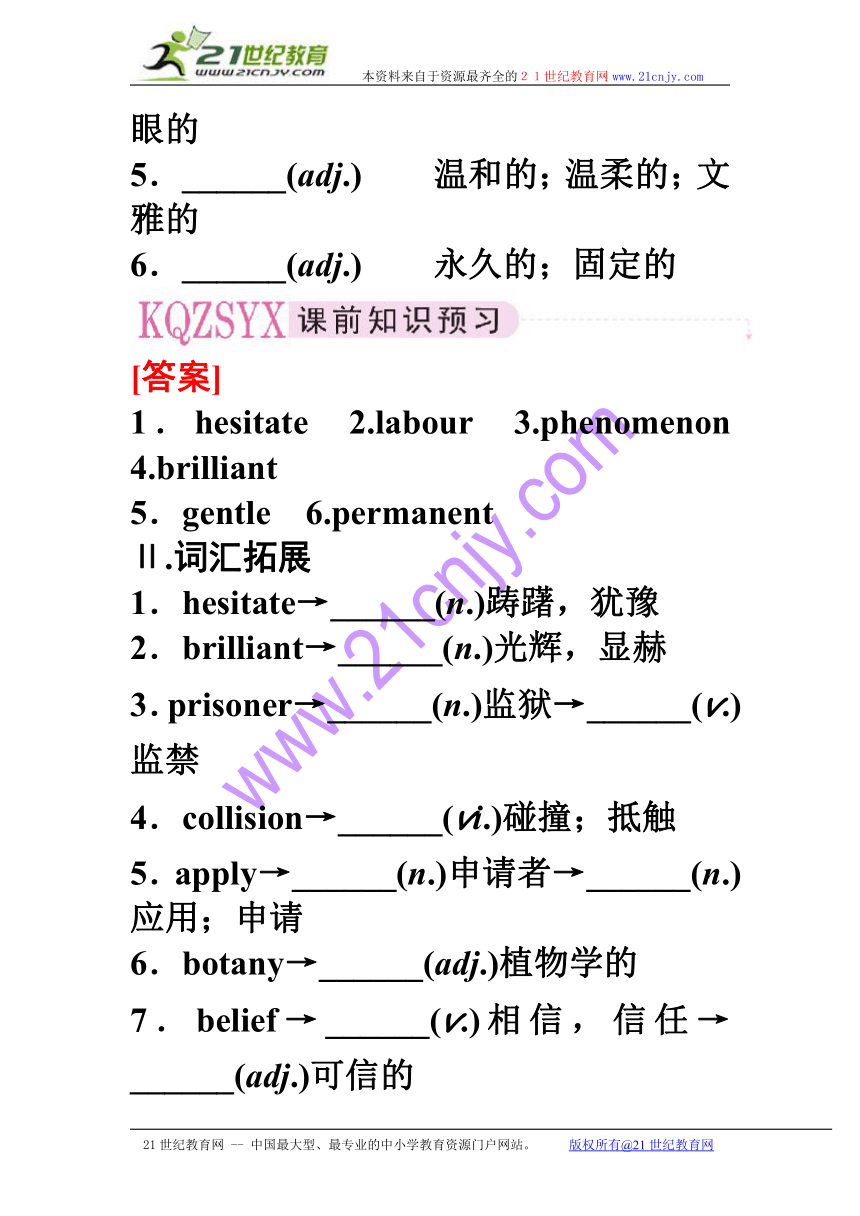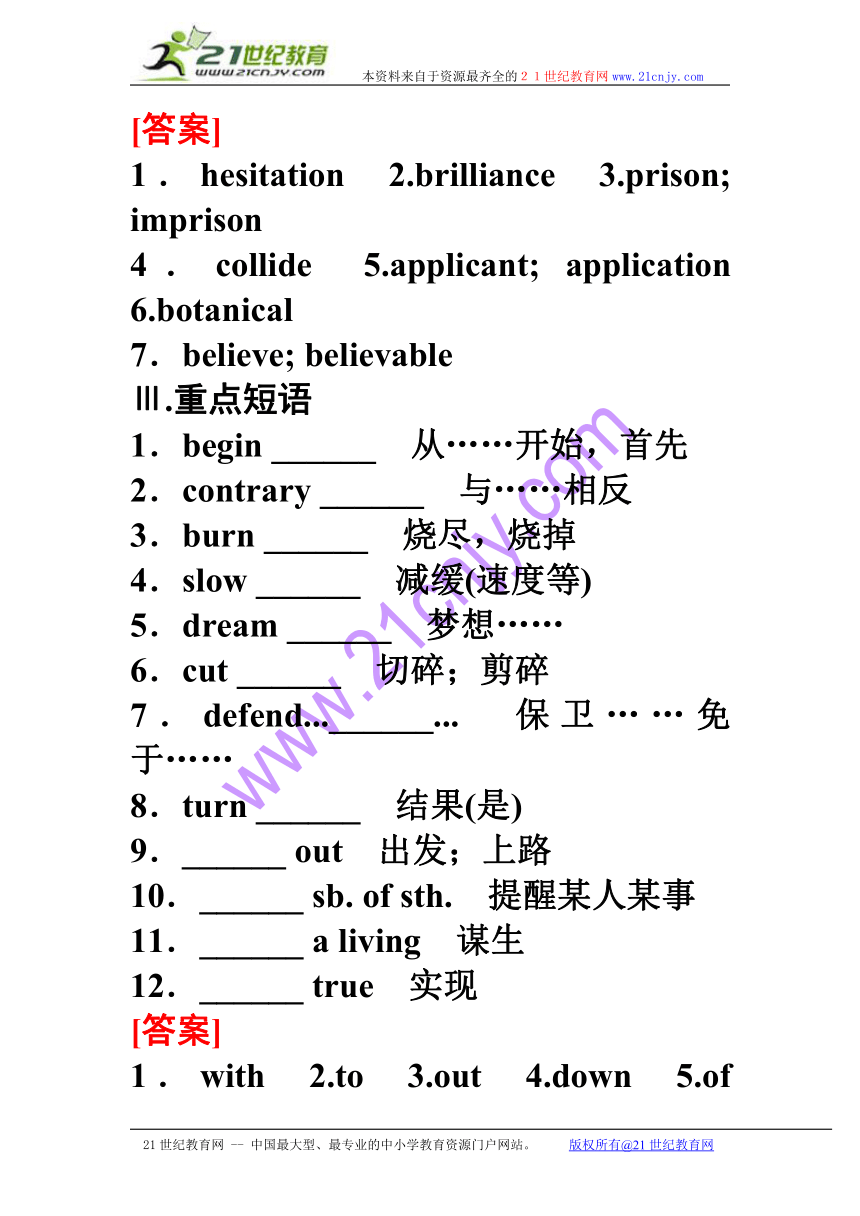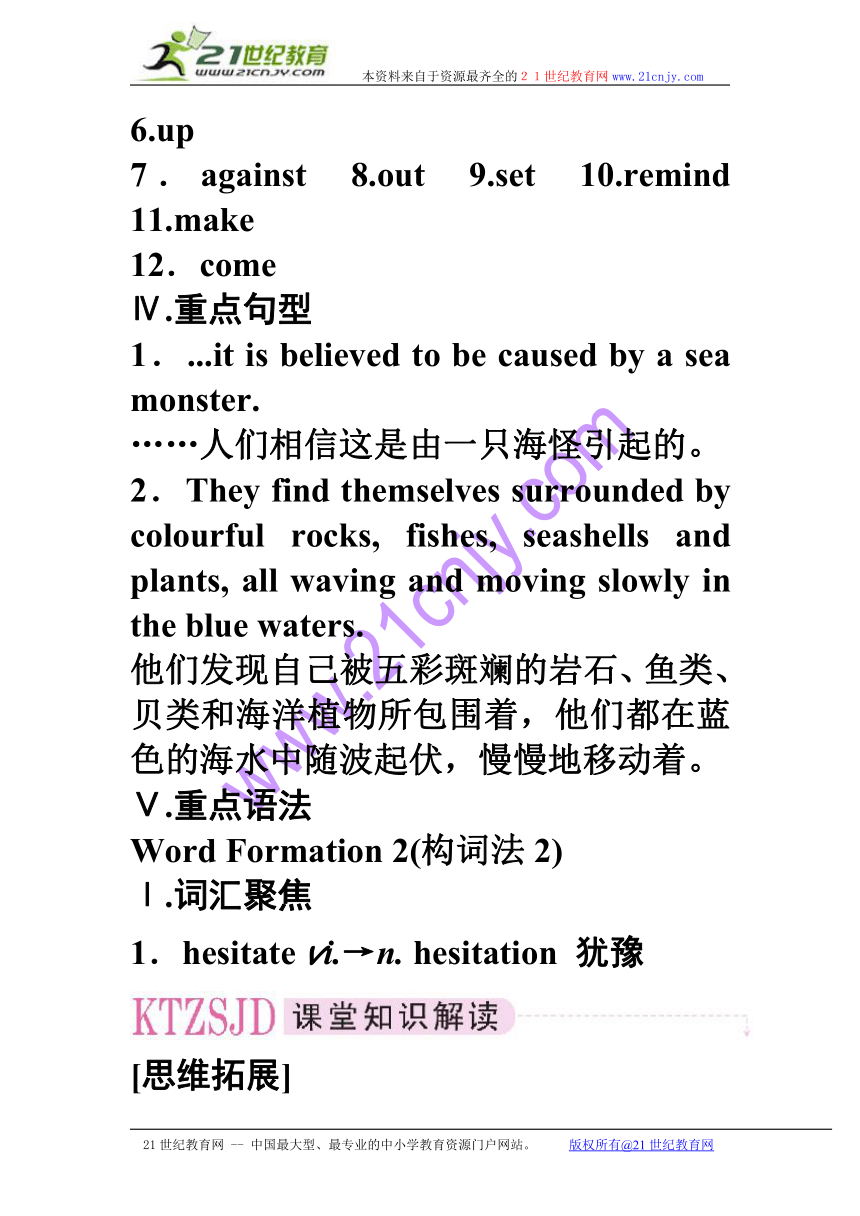备考2011高效学习方案英语高二册:unit 12 fact and fantasy
文档属性
| 名称 | 备考2011高效学习方案英语高二册:unit 12 fact and fantasy |  | |
| 格式 | rar | ||
| 文件大小 | 352.2KB | ||
| 资源类型 | 教案 | ||
| 版本资源 | 人教版 | ||
| 科目 | 英语 | ||
| 更新时间 | 2010-12-14 17:12:00 | ||
图片预览





文档简介
本资料来自于资源最齐全的21世纪教育网www.21cnjy.com
Unit 12 Fact and fantasy
(2009·北京)请根据下面提示,写一篇短文,词数不少于50。
________________________________________
[参考答案]
What an interesting picture! A Western young man, sitting at a table, is ready to eat a bowl of noodles. He is holding two forks the same way as we Chinese hold chopsticks. He is trying so hard to pick up the noodles that he is sweating a lot. At first glance, I think it’s a bit funny, for we Chinese take for granted that chopsticks are the tools for eating noodles. The man in the picture is trying to copy us. Obviously he is doing it the hard way. Maybe using one fork will do a better job. In my opinion, we don’t need to copy others’ ways of thinking. Sometimes a simpler way of doing things may be a better way.
Ⅰ.重点单词
1.______(vi.) 踌躇;犹豫
2.______(n.) 努力;(体力)劳动
3.______(n.) 现象;奇迹
4.______(adj.) 聪明的;杰出的;耀眼的
5.______(adj.) 温和的;温柔的;文雅的
6.______(adj.) 永久的;固定的
[答案]
1.hesitate 2.labour 3.phenomenon 4.brilliant
5.gentle 6.permanent
Ⅱ.词汇拓展
1.hesitate→______(n.)踌躇,犹豫
2.brilliant→______(n.)光辉,显赫
3.prisoner→______(n.)监狱→______(v.)监禁
4.collision→______(vi.)碰撞;抵触
5.apply→______(n.)申请者→______(n.)应用;申请
6.botany→______(adj.)植物学的
7.belief→______(v.)相信,信任→______(adj.)可信的
[答案]
1.hesitation 2.brilliance 3.prison; imprison
4.collide 5.applicant; application 6.botanical
7.believe; believable
Ⅲ.重点短语
1.begin ______ 从……开始,首先
2.contrary ______ 与……相反
3.burn ______ 烧尽,烧掉
4.slow ______ 减缓(速度等)
5.dream ______ 梦想……
6.cut ______ 切碎;剪碎
7.defend...______... 保卫……免于……
8.turn ______ 结果(是)
9.______ out 出发;上路
10.______ sb. of sth. 提醒某人某事
11.______ a living 谋生
12.______ true 实现
[答案]
1.with 2.to 3.out 4.down 5.of 6.up
7.against 8.out 9.set 10.remind 11.make
12.come
Ⅳ.重点句型
1....it is believed to be caused by a sea monster.
……人们相信这是由一只海怪引起的。
2.They find themselves surrounded by colourful rocks, fishes, seashells and plants, all waving and moving slowly in the blue waters.
他们发现自己被五彩斑斓的岩石、鱼类、贝类和海洋植物所包围着,他们都在蓝色的海水中随波起伏,慢慢地移动着。
Ⅴ.重点语法
Word Formation 2(构词法2)
Ⅰ.词汇聚焦
1.hesitate vi.→n. hesitation 犹豫
[思维拓展]
hesitate in speaking说话吞吞吐吐
without hesitation毫不犹豫地
feel some hesitation in accepting invitation
对接受邀请有点犹豫不决
Without a moment’s ______, she jumped into the river after the child.
A. waiting B. hesitate
C. hesitation D. silence
解析:without作为介词,后面须跟n., pron.或v.-ing。wait本身可作n.,故可排除A;B为动词;D为“沉默”,与题意不符。
答案:C
2.common adj. 共同的,共用的,普通的,常见的
[思维拓展]
have sth. in common和……有共同之处
have nothing in common和……没有共同之处
in common with和……一样,与……有共同之处
be common to/for sb.对……共有的(常见的)
[指点迷津]
common, general, ordinary与usual
common指符合全体事物共同特征的、普遍的,如:common sense“常识”;用于物指“不稀奇,很平常”,用于人指“没有职业,不高贵”。general指相对于个别而言,一般的。如:general knowledge“普通知识”;用于物指“包括一切的,很少有例外的”,用于人指“绝大多数人都适用的”。
ordinary用于物指平常的,平淡的,用于人指“无特殊地位的,没有优越感的”。如:ordinary dress“便服”。
usual强调习惯性,一贯如此。如:as usual“照例”。
______ other young men, he also enjoys pop music.
A. Compared with B. In common with
C. Except for D. Speaking of
解析:由于受后面also的限制,A、C不合句意和结构。D项与he的逻辑关系不对,不能选择。句意是“与其他年轻人一样,他也喜欢流行音乐”。故选B。
答案:B
3.dislike v. & n. 不喜欢,厌恶
[思维拓展]
dislike+n. 不喜欢……
dislike doing sth.不喜欢干某事
have a dislike of/for不喜欢……
likes and dislikes好恶
take a dislike to对……产生反感
[指点迷津]
dislike等由否定意义的词缀构成的词,要按常规构成反意疑问句。如:
She dislikes swimming, doesn’t she
That is unusual, isn’t that
比较:She seldom goes to swim, does she
He hardly writes to you, does he
______ his sister, Jack is quiet and does not easily make friends with others.
A. Dislike B. Unlike
C. Alike D. Liking
解析:A为v.“不喜欢,厌恶”;B为prep.“不像,和……不同”;C为adj.“相像的,相似的”;D为n.“爱好”。根据题干,此处应使用prep.。
答案:B
4.desire v. & n. 渴望,希望;愿望,要求
[思维拓展]
desire sth.
desire to do sth.
desire sb. to do sth.
The manager desired that all of us ______ as soon as possible.
A. take measures B. took measures
C. to take measures D. taking measures
解析:desire后跟从句须用虚拟语气,且should可以省略,desire后不跟动名词。
答案:A
5.doubt n. & v. 怀疑
[思维拓展]
in doubt不能确定
without doubt毫无疑问地
throw doubt upon...对……表示怀疑
There is no doubt about毫无疑问……。
have no doubt about毫无疑问
[指点迷津]
①doubt用作动词,后接从句,主句是肯定句,用if或whether引导,主句是疑问句或否定句则用that引导。
I doubt whether he’ll be successful.
I don’t doubt that he’ll be successful.
Do you doubt that he’ll be successful
②名词doubt后接同位语从句,否定句、疑问句用that引导,肯定句用whether引导。
There is no doubt that he’ll be successful.
Is there any doubt that he’ll be successful
I have doubt whether he’ll be successful.
Is there any doubt ______ it is going to rain
A. if B. whether
C. when D. that
解析:在疑问句、否定句中,doubt后面的从句用that引导。在肯定句中,doubt后的从句用whether/if引导。
答案:D
Ⅱ.短语突破
1.throw...upon/on把……投向……,把……引导到……
[思维拓展]
throw light upon阐明,使明白
throw shadows on把影子投射到
throw doubt on对……产生怀疑
throw away扔掉
throw...at...向着……扔……
throw on/off匆匆穿上/脱下……
throw sb. into prison把某人关进监狱
What a pity! He ______ the only chance of success.
A. threw away B. put down
C. gave in D. broke off
解析:throw away“扔掉;坐失(良机等)”;put down“写下,记下;平息”;give in“屈服,投降”;break off“折断”。根据句意“他失去了最后的成功机会,真遗憾!”,答案应为throw away。
答案:A
2.deal with对付,处理
[思维拓展]
①对付,应付,处理,安排
Deal with a man as he deals with you.
以其人之道还治其人之身。
②论述,涉及
a book dealing with Asian problems
一本论述亚洲问题的书
③做买卖
deal with that store和那家商店做买卖
[指点迷津]
do with
①与……相处
②忍受
③对付,处置
④have done with做完,用毕,已和……无关,已和……断绝关系
⑤have to do with和……有关,和……打交道
⑥do with与deal with都可表示“处理”,其不同点在于deal with常与连接副词how连用,而do with常与连接代词what连用。
3.make a living
[思维拓展]
make a living谋生
earn a living谋生
plain living简朴的生活
a decline in living standards生活水平的下降
way of life生活方式
the greatest living English writer
还活在世上的英国最伟大的作家
①She earns a living as a writer.
②What do you do for a living
③She has no living relatives.
4.cut up
[思维拓展]
cut up切碎,砍碎,使伤心
cut off切断;砍断
cut out切掉;剪下;戒除,改掉
cut down砍;削减,减少
cut in插嘴;超车抢道
With the electricity ______, all the machines stopped.
A. cut off B. cut down
C. was cut off D. was cut down
解析:此处with复合结构的宾语electricity与cut off存在被动关系,因此用过去分词的形式表被动。cut down“砍倒;削减”与句意不符。
答案:A
5.begin with
[思维拓展]
begin with=start with以……开始
end with=end up with以……结束
[指点迷津]
end up“以……而告终”,含有“最终结局不好”之意。
Many battles were brought about but the settlers ______ better land than the Native Americans.
A. ended with B. ended up in
C. finished with D. ended up as
解析:end (up) with“以……而结束”;end up as“最终成为……”。
答案:A
6.on board 上船(或火车、公共汽车、飞机等)
[思维拓展]
go on board上船/上火车/上飞机
stay on board在船上/火车上/飞机上
①The ship had 500 passengers on board.
②There were ten men on board the plane.
③I’ll manage to go on board somehow.
One of the sailors was not ______ when the ship sailed off.
A. on the board B. in board
C. on board D. above the board
解析:on board是一个固定词组,board前不加冠词。
答案:C
Ⅲ.句型归纳
They find themselves surrounded by colourful rocks, fishes, seashells and plants, all waving and moving slowly in the blue waters.他们发现自己被五彩的岩石、鱼类、贝类及海中植物包围着,它们都在蓝色的海水中慢慢地游动着,移动着。
(1)find themselves surrounded by...结构是“find+宾语+宾补”的形式,表示“发现某人/某物怎么样了”。“find oneself+宾语”表示“发现自己不知不觉处于某种状态”。
[思维拓展]
find sb./sth. to be“发现某人/某物是”
He hurried to the station only ______ the train ______.
A. to find; had left
B. finding; left
C. found; leave
D. to have found; to leave
解析:考查不定式作结果状语和find的用法。现在分词和不定式都可以表示结果,但现在分词往往表示意料之中的事情,而不定式多表示出乎意料的事情,根据题意分析表示的是出乎意料的事情,因此用不定式作结果状语。第二个空用过去完成时,表示过去的过去,表示到达车站时火车已经离开。
答案:A
(2)...all waving and moving slowly in the blue waters该结构为独立主格结构,在句中作伴随状语。
[思维拓展]
①Time permitting, we’ll go out tomorrow.(条件状语→名词+现在分词)
②Everything considered, we decided to take measures tonight.(时间状语→名词+过去分词)
③Spring coming on, the fields turn green.(时间状语→名词+现在分词)
④All his money lost, he bought nothing.(原因状语→名词+过去分词)
⑤It’s his first kid, the second to come too.(伴随状语→名词+不定式)
⑥He came home, his nose red with cold.(伴随状语→名词+形容词短语)
⑦Classes over, everybody ran out.(时间状语→名词+副词)
⑧The boy stood still, hands in his pockets.(伴随状语→名词+介词短语)
⑨She has two sons, one six, the other ten.(伴随状语→名词+数词)
[指点迷津]
①独立主格结构在句中作状语,有时可以转换为状语从句。
②独立主格结构前有时可加介词with,构成with复合结构。
A letter ______, he hurried to the shop for some shopping.
A. posting
B. having posted
C. posted
D. had been posted
解析:前后两部分句子中不含连接词。因此该句不是主从复合句,D项作谓语动词使用,故可排除。a letter与post之间构成逻辑上的动宾关系,但从句式上a letter又处于主语的位置,因此此处应为过去分词构成独立主格结构。
答案:C
21世纪教育网 -- 中国最大型、最专业的中小学教育资源门户网站。 版权所有@21世纪教育网
Unit 12 Fact and fantasy
(2009·北京)请根据下面提示,写一篇短文,词数不少于50。
________________________________________
[参考答案]
What an interesting picture! A Western young man, sitting at a table, is ready to eat a bowl of noodles. He is holding two forks the same way as we Chinese hold chopsticks. He is trying so hard to pick up the noodles that he is sweating a lot. At first glance, I think it’s a bit funny, for we Chinese take for granted that chopsticks are the tools for eating noodles. The man in the picture is trying to copy us. Obviously he is doing it the hard way. Maybe using one fork will do a better job. In my opinion, we don’t need to copy others’ ways of thinking. Sometimes a simpler way of doing things may be a better way.
Ⅰ.重点单词
1.______(vi.) 踌躇;犹豫
2.______(n.) 努力;(体力)劳动
3.______(n.) 现象;奇迹
4.______(adj.) 聪明的;杰出的;耀眼的
5.______(adj.) 温和的;温柔的;文雅的
6.______(adj.) 永久的;固定的
[答案]
1.hesitate 2.labour 3.phenomenon 4.brilliant
5.gentle 6.permanent
Ⅱ.词汇拓展
1.hesitate→______(n.)踌躇,犹豫
2.brilliant→______(n.)光辉,显赫
3.prisoner→______(n.)监狱→______(v.)监禁
4.collision→______(vi.)碰撞;抵触
5.apply→______(n.)申请者→______(n.)应用;申请
6.botany→______(adj.)植物学的
7.belief→______(v.)相信,信任→______(adj.)可信的
[答案]
1.hesitation 2.brilliance 3.prison; imprison
4.collide 5.applicant; application 6.botanical
7.believe; believable
Ⅲ.重点短语
1.begin ______ 从……开始,首先
2.contrary ______ 与……相反
3.burn ______ 烧尽,烧掉
4.slow ______ 减缓(速度等)
5.dream ______ 梦想……
6.cut ______ 切碎;剪碎
7.defend...______... 保卫……免于……
8.turn ______ 结果(是)
9.______ out 出发;上路
10.______ sb. of sth. 提醒某人某事
11.______ a living 谋生
12.______ true 实现
[答案]
1.with 2.to 3.out 4.down 5.of 6.up
7.against 8.out 9.set 10.remind 11.make
12.come
Ⅳ.重点句型
1....it is believed to be caused by a sea monster.
……人们相信这是由一只海怪引起的。
2.They find themselves surrounded by colourful rocks, fishes, seashells and plants, all waving and moving slowly in the blue waters.
他们发现自己被五彩斑斓的岩石、鱼类、贝类和海洋植物所包围着,他们都在蓝色的海水中随波起伏,慢慢地移动着。
Ⅴ.重点语法
Word Formation 2(构词法2)
Ⅰ.词汇聚焦
1.hesitate vi.→n. hesitation 犹豫
[思维拓展]
hesitate in speaking说话吞吞吐吐
without hesitation毫不犹豫地
feel some hesitation in accepting invitation
对接受邀请有点犹豫不决
Without a moment’s ______, she jumped into the river after the child.
A. waiting B. hesitate
C. hesitation D. silence
解析:without作为介词,后面须跟n., pron.或v.-ing。wait本身可作n.,故可排除A;B为动词;D为“沉默”,与题意不符。
答案:C
2.common adj. 共同的,共用的,普通的,常见的
[思维拓展]
have sth. in common和……有共同之处
have nothing in common和……没有共同之处
in common with和……一样,与……有共同之处
be common to/for sb.对……共有的(常见的)
[指点迷津]
common, general, ordinary与usual
common指符合全体事物共同特征的、普遍的,如:common sense“常识”;用于物指“不稀奇,很平常”,用于人指“没有职业,不高贵”。general指相对于个别而言,一般的。如:general knowledge“普通知识”;用于物指“包括一切的,很少有例外的”,用于人指“绝大多数人都适用的”。
ordinary用于物指平常的,平淡的,用于人指“无特殊地位的,没有优越感的”。如:ordinary dress“便服”。
usual强调习惯性,一贯如此。如:as usual“照例”。
______ other young men, he also enjoys pop music.
A. Compared with B. In common with
C. Except for D. Speaking of
解析:由于受后面also的限制,A、C不合句意和结构。D项与he的逻辑关系不对,不能选择。句意是“与其他年轻人一样,他也喜欢流行音乐”。故选B。
答案:B
3.dislike v. & n. 不喜欢,厌恶
[思维拓展]
dislike+n. 不喜欢……
dislike doing sth.不喜欢干某事
have a dislike of/for不喜欢……
likes and dislikes好恶
take a dislike to对……产生反感
[指点迷津]
dislike等由否定意义的词缀构成的词,要按常规构成反意疑问句。如:
She dislikes swimming, doesn’t she
That is unusual, isn’t that
比较:She seldom goes to swim, does she
He hardly writes to you, does he
______ his sister, Jack is quiet and does not easily make friends with others.
A. Dislike B. Unlike
C. Alike D. Liking
解析:A为v.“不喜欢,厌恶”;B为prep.“不像,和……不同”;C为adj.“相像的,相似的”;D为n.“爱好”。根据题干,此处应使用prep.。
答案:B
4.desire v. & n. 渴望,希望;愿望,要求
[思维拓展]
desire sth.
desire to do sth.
desire sb. to do sth.
The manager desired that all of us ______ as soon as possible.
A. take measures B. took measures
C. to take measures D. taking measures
解析:desire后跟从句须用虚拟语气,且should可以省略,desire后不跟动名词。
答案:A
5.doubt n. & v. 怀疑
[思维拓展]
in doubt不能确定
without doubt毫无疑问地
throw doubt upon...对……表示怀疑
There is no doubt about毫无疑问……。
have no doubt about毫无疑问
[指点迷津]
①doubt用作动词,后接从句,主句是肯定句,用if或whether引导,主句是疑问句或否定句则用that引导。
I doubt whether he’ll be successful.
I don’t doubt that he’ll be successful.
Do you doubt that he’ll be successful
②名词doubt后接同位语从句,否定句、疑问句用that引导,肯定句用whether引导。
There is no doubt that he’ll be successful.
Is there any doubt that he’ll be successful
I have doubt whether he’ll be successful.
Is there any doubt ______ it is going to rain
A. if B. whether
C. when D. that
解析:在疑问句、否定句中,doubt后面的从句用that引导。在肯定句中,doubt后的从句用whether/if引导。
答案:D
Ⅱ.短语突破
1.throw...upon/on把……投向……,把……引导到……
[思维拓展]
throw light upon阐明,使明白
throw shadows on把影子投射到
throw doubt on对……产生怀疑
throw away扔掉
throw...at...向着……扔……
throw on/off匆匆穿上/脱下……
throw sb. into prison把某人关进监狱
What a pity! He ______ the only chance of success.
A. threw away B. put down
C. gave in D. broke off
解析:throw away“扔掉;坐失(良机等)”;put down“写下,记下;平息”;give in“屈服,投降”;break off“折断”。根据句意“他失去了最后的成功机会,真遗憾!”,答案应为throw away。
答案:A
2.deal with对付,处理
[思维拓展]
①对付,应付,处理,安排
Deal with a man as he deals with you.
以其人之道还治其人之身。
②论述,涉及
a book dealing with Asian problems
一本论述亚洲问题的书
③做买卖
deal with that store和那家商店做买卖
[指点迷津]
do with
①与……相处
②忍受
③对付,处置
④have done with做完,用毕,已和……无关,已和……断绝关系
⑤have to do with和……有关,和……打交道
⑥do with与deal with都可表示“处理”,其不同点在于deal with常与连接副词how连用,而do with常与连接代词what连用。
3.make a living
[思维拓展]
make a living谋生
earn a living谋生
plain living简朴的生活
a decline in living standards生活水平的下降
way of life生活方式
the greatest living English writer
还活在世上的英国最伟大的作家
①She earns a living as a writer.
②What do you do for a living
③She has no living relatives.
4.cut up
[思维拓展]
cut up切碎,砍碎,使伤心
cut off切断;砍断
cut out切掉;剪下;戒除,改掉
cut down砍;削减,减少
cut in插嘴;超车抢道
With the electricity ______, all the machines stopped.
A. cut off B. cut down
C. was cut off D. was cut down
解析:此处with复合结构的宾语electricity与cut off存在被动关系,因此用过去分词的形式表被动。cut down“砍倒;削减”与句意不符。
答案:A
5.begin with
[思维拓展]
begin with=start with以……开始
end with=end up with以……结束
[指点迷津]
end up“以……而告终”,含有“最终结局不好”之意。
Many battles were brought about but the settlers ______ better land than the Native Americans.
A. ended with B. ended up in
C. finished with D. ended up as
解析:end (up) with“以……而结束”;end up as“最终成为……”。
答案:A
6.on board 上船(或火车、公共汽车、飞机等)
[思维拓展]
go on board上船/上火车/上飞机
stay on board在船上/火车上/飞机上
①The ship had 500 passengers on board.
②There were ten men on board the plane.
③I’ll manage to go on board somehow.
One of the sailors was not ______ when the ship sailed off.
A. on the board B. in board
C. on board D. above the board
解析:on board是一个固定词组,board前不加冠词。
答案:C
Ⅲ.句型归纳
They find themselves surrounded by colourful rocks, fishes, seashells and plants, all waving and moving slowly in the blue waters.他们发现自己被五彩的岩石、鱼类、贝类及海中植物包围着,它们都在蓝色的海水中慢慢地游动着,移动着。
(1)find themselves surrounded by...结构是“find+宾语+宾补”的形式,表示“发现某人/某物怎么样了”。“find oneself+宾语”表示“发现自己不知不觉处于某种状态”。
[思维拓展]
find sb./sth. to be“发现某人/某物是”
He hurried to the station only ______ the train ______.
A. to find; had left
B. finding; left
C. found; leave
D. to have found; to leave
解析:考查不定式作结果状语和find的用法。现在分词和不定式都可以表示结果,但现在分词往往表示意料之中的事情,而不定式多表示出乎意料的事情,根据题意分析表示的是出乎意料的事情,因此用不定式作结果状语。第二个空用过去完成时,表示过去的过去,表示到达车站时火车已经离开。
答案:A
(2)...all waving and moving slowly in the blue waters该结构为独立主格结构,在句中作伴随状语。
[思维拓展]
①Time permitting, we’ll go out tomorrow.(条件状语→名词+现在分词)
②Everything considered, we decided to take measures tonight.(时间状语→名词+过去分词)
③Spring coming on, the fields turn green.(时间状语→名词+现在分词)
④All his money lost, he bought nothing.(原因状语→名词+过去分词)
⑤It’s his first kid, the second to come too.(伴随状语→名词+不定式)
⑥He came home, his nose red with cold.(伴随状语→名词+形容词短语)
⑦Classes over, everybody ran out.(时间状语→名词+副词)
⑧The boy stood still, hands in his pockets.(伴随状语→名词+介词短语)
⑨She has two sons, one six, the other ten.(伴随状语→名词+数词)
[指点迷津]
①独立主格结构在句中作状语,有时可以转换为状语从句。
②独立主格结构前有时可加介词with,构成with复合结构。
A letter ______, he hurried to the shop for some shopping.
A. posting
B. having posted
C. posted
D. had been posted
解析:前后两部分句子中不含连接词。因此该句不是主从复合句,D项作谓语动词使用,故可排除。a letter与post之间构成逻辑上的动宾关系,但从句式上a letter又处于主语的位置,因此此处应为过去分词构成独立主格结构。
答案:C
21世纪教育网 -- 中国最大型、最专业的中小学教育资源门户网站。 版权所有@21世纪教育网
同课章节目录
